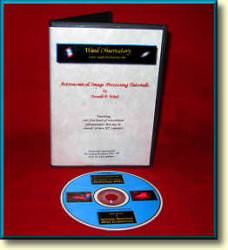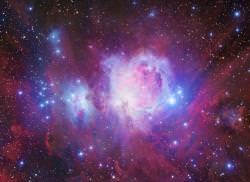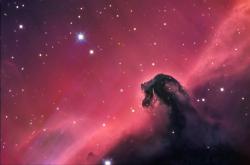 Astrophotography is an exhilarating pastime. Thanks to the digital revolution in amateur astronomy, taking deep space images is less of the almost overwhelming challenge it was just a handful of years ago. Today, with a modest telescope and digital camera, thousands of enthusiasts are producing beautiful images of galaxies and nebulas. However, one final hurdle persists- raw images produced through a telescope still require significant enhancement to bring out the secrets hidden within them. This can be a daunting procedure because processing astrophotographs has been, and remains, an essentially self-taught art. However, several imaging experts who have been honing their processing skills for many years have recently begun to reveal their hard learned techniques through books and, in 2006, with DVD tutorials.
Astrophotography is an exhilarating pastime. Thanks to the digital revolution in amateur astronomy, taking deep space images is less of the almost overwhelming challenge it was just a handful of years ago. Today, with a modest telescope and digital camera, thousands of enthusiasts are producing beautiful images of galaxies and nebulas. However, one final hurdle persists- raw images produced through a telescope still require significant enhancement to bring out the secrets hidden within them. This can be a daunting procedure because processing astrophotographs has been, and remains, an essentially self-taught art. However, several imaging experts who have been honing their processing skills for many years have recently begun to reveal their hard learned techniques through books and, in 2006, with DVD tutorials.
Continue reading “Book Review: Astronomical Image Processing Tutorials by Donald P. Waid”
Astrophoto: Orion Deep field by Robert Gendler
 We live in an age filled with robots- both those that respond to commands issued by a person and those that autonomously respond to a program placed within their operating system. Regardless of how they function, and more fundamentally, robots are tools meant to perform tasks that are repetitive or dangerous, often in situations requiring high precision or to serve as human proxy. Interestingly, robots have also been a staple in fiction since antiquity- one of the earliest examples was the bronze giant, Talos, in Homer’s IIiad. They have also been used as an elaborate metaphor for humankind’s relationship with technology. So, whether the term “robot” conjures up a vision of Frankenstein or Tickle Me Elmo, they no longer are just a figment of fertile imaginations and humankind’s reliance is growing exponentially. For example, robots are increasingly playing a significant role in amateur astronomy- the image that accompanies this discussion was produced through robotic assistance.
We live in an age filled with robots- both those that respond to commands issued by a person and those that autonomously respond to a program placed within their operating system. Regardless of how they function, and more fundamentally, robots are tools meant to perform tasks that are repetitive or dangerous, often in situations requiring high precision or to serve as human proxy. Interestingly, robots have also been a staple in fiction since antiquity- one of the earliest examples was the bronze giant, Talos, in Homer’s IIiad. They have also been used as an elaborate metaphor for humankind’s relationship with technology. So, whether the term “robot” conjures up a vision of Frankenstein or Tickle Me Elmo, they no longer are just a figment of fertile imaginations and humankind’s reliance is growing exponentially. For example, robots are increasingly playing a significant role in amateur astronomy- the image that accompanies this discussion was produced through robotic assistance.
Continue reading “Astrophoto: Orion Deep field by Robert Gendler”
Astrophoto: The Horsehead Nebula by Filippo Ciferri
 Animals have always been important subjects for sculpture. In its earliest representations, the purpose was to gain control over the creature or to confer magical powers- equestrian statues, especially so. Thus, over the ages, the horse became an icon of civilization. Sculptures of horses have meant different things to different cultures- initially as prey then as abundance. During Antiquity the horse was viewed as the embodiment of power and more recently it has been used as a metaphor for freedom, journeys to distant places and the pursuit of personal dreams. To many, the horse has taken on a monumental stature that stirs deep-seated feelings whether it is carved out of rock or composed of ephemeral wisps in the dim reaches of outer space.
Animals have always been important subjects for sculpture. In its earliest representations, the purpose was to gain control over the creature or to confer magical powers- equestrian statues, especially so. Thus, over the ages, the horse became an icon of civilization. Sculptures of horses have meant different things to different cultures- initially as prey then as abundance. During Antiquity the horse was viewed as the embodiment of power and more recently it has been used as a metaphor for freedom, journeys to distant places and the pursuit of personal dreams. To many, the horse has taken on a monumental stature that stirs deep-seated feelings whether it is carved out of rock or composed of ephemeral wisps in the dim reaches of outer space.
Continue reading “Astrophoto: The Horsehead Nebula by Filippo Ciferri”
Book Review: Making Every Pixel Count, Vol. 1-3
![]() Astronomy has many unfair advantages over the other natural sciences because it captures elements of travel, adventure and discovery. One glimpse through eyepiece filled with thousands of previously unseen stars has lured many casual observers into a head-over-heels love affair with the night sky that remains with them for the rest of their life. The dazzling images reproduced in magazines, books and movies also plant dreams of taking similar images in the minds of more than a few would-be astronomers, too! However, producing astronomical imagery is not for the feint hearted. It involves patience, perseverance and until very recently, a measure of luck. Much of that has changed with the introduction of computerized telescopes and affordable digital cameras. This year has also seen a small explosion of books and DVD tutorials that explain how to transform raw deep space images into picture postcards of the Universe!
Astronomy has many unfair advantages over the other natural sciences because it captures elements of travel, adventure and discovery. One glimpse through eyepiece filled with thousands of previously unseen stars has lured many casual observers into a head-over-heels love affair with the night sky that remains with them for the rest of their life. The dazzling images reproduced in magazines, books and movies also plant dreams of taking similar images in the minds of more than a few would-be astronomers, too! However, producing astronomical imagery is not for the feint hearted. It involves patience, perseverance and until very recently, a measure of luck. Much of that has changed with the introduction of computerized telescopes and affordable digital cameras. This year has also seen a small explosion of books and DVD tutorials that explain how to transform raw deep space images into picture postcards of the Universe!
Continue reading “Book Review: Making Every Pixel Count, Vol. 1-3”
Astrophoto: The Great Andromeda Galaxy- M31 by Takayuki Yoshida
Our lives in the early 21st Century can be characterized by many words and phrases. One of them, surely, is our sense of instantaneousness! For the first time in human history, practically any person on the planet can have a live conversation with anyone else using the now ubiquitous cell phone, as one example. Our voices, text messages, pictures and, increasingly, streaming media bounce effortlessly at the speed of light from hand held devices through ground based repeaters to satellite transponders and vice versa. I suspect, our great grandparents would be stupefied by all of this because we have essentially managed to bring the distance between all points on Earth to a practical zero point. Yet, we are surrounded (no, we are engulfed) by circumstances that are in stark contrast to our modern sense of reality. To understand what I am referencing, look up at the sky or take a peek at the accompanying picture.
Continue reading “Astrophoto: The Great Andromeda Galaxy- M31 by Takayuki Yoshida”
Astrophoto: Van den Bergh 152 by Giovanni Benintende
Go to a public place where people gather such as a rush hour sidewalk downtown or a weekend shopping mall and you’ll quickly notice that each person is an individual with diverse characteristics based on their height, weight and countenance, for example. Such is also true of the stars that congregate above. Each are distinct by size, shape, age, and color. There’s also one other trait that’s immediately noticeable at first glance- each star has a unique brilliance.
Continue reading “Astrophoto: Van den Bergh 152 by Giovanni Benintende”
Astrophoto: M83 by R. Jay GaBany
Our understanding of the Universe is written in pencil on the pages of a loose-leaf notebook because, like many of the sciences, our knowledge of nature is constantly undergoing revision. For example, during the past few years a quiet revolution has been taking place regarding galaxies, black holes and their increasingly understood symbiotic relationship. Black holes, which were once considered scientific novelties, are now seen as fundamental forces shaping the Universe. Observations obtained since the turn of the 21st century have offered evidence that virtually all galaxies, such as M83 pictured here, harbor a king size black hole at their center- including our Milky Way!
Continue reading “Astrophoto: M83 by R. Jay GaBany”
Astrophoto: From the Soul Nebula by Frank Barnes III
In June of 1889, about one year before his untimely death, the brilliant Dutch post-impressionist, Vincent Van Gogh, furiously completed The Starry Night while staying at the Monastery Saint-Paul de Mausole, a mental asylum located in Southern France. The painting depicts a humble village nestled between the blue tranquility of undulating hills and a magical sky filled with comet shaped clouds and cartwheeling stars the size of Ferris wheels. Even though Van Gogh only sold one painting during his lifetime, this priceless work of art has become an icon. In it he captured a childlike wonder that adults can recognize for who has not stood outside and been swayed by twinkling stars celebrating overhead. Beautiful deep space images can elicit similar excitement from astronomical enthusiasts. However, the photographers who produce them are more interested in the stars when they are peaceful.
Continue reading “Astrophoto: From the Soul Nebula by Frank Barnes III”
Astrophoto: The Witch Head Nebula by Richard Payne
Since 1989, when the first extra solar planet was detected, 180 planetary systems featuring 210 planets have been identified as of October 19, 2006. Each discovery has been a remarkable achievement. However, not one of these worlds has yet to be observed visually and there is not a shred of evidence that any are capable of harboring life, as we know it. But that has not throttled the creative energy of writers, television producers and movie directors from their unbridled speculation that the Universe is bursting with intelligent beings. In fact, the unprecedented discovery of these planets has seemed somewhat anticlimactic to science fiction fans raised on H.G. Wells, Gene Roddenberry and George Lucas tales. To many sci-fi buffs, science is simply confirming their long held beliefs. For example, according to the Star Trek universe, Rigel, the off camera star which illuminates the accompanying picture, has twelve planets that support Federation colonies.
Continue reading “Astrophoto: The Witch Head Nebula by Richard Payne”
Astrophoto: Swan Song for a Comet
On December 2, 1995, the SOHO (Solar and Heliospheric Observatory) spacecraft was launched aboard an Atlas/Centaur rocket from Cape Canaveral Air Station on a two-year mission to monitor the sun. Almost eleven years later, the SOHO spacecraft continues to faithfully record solar activity orbiting the Sun about 1.5-million kilometers inward from Earth. NASA and the European Space Agency operate the satellite jointly. Everyday, SOHO transmits pictures that are freely available for viewing on the Internet. These images inform scientists around the world about the Sun’s nature and behavior. Its images and data enable them to predict “space weather” events affecting our planet. Earlier in July of this year, someone discovered a new comet in a SOHO picture and now it’s gracing our evening skies as seen in this telescopic image.
Continue reading “Astrophoto: Swan Song for a Comet”
